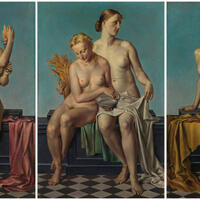More about John Roddam Spencer Stanhope
- All
- Info
- Shop
Works by John Roddam Spencer Stanhope

Sr. Contributor
John Roddam Spencer Stanhope has four names, but one unique style.
Johnny was born into a large well-to-do landed family. While there were too many kids in the Spencer Stanhope clan to mean John Roddam would get any real inheritance upon reaching adulthood, the parents had an idea on how to provide for little John: Educate the hell out of the rugrat. So off to the best schools for Jack R. In Rugby, then Christchurch at Oxford. Truly, there couldn't be anything other than a bright future as a nice businessman. Maybe, dare they hope, as a leading barrister! He was even a rising star in the West Yorkshire militia, eventually reaching the rank of captain. So, war! War for their son. Huzzah!
But the joy of such promise was cast asunder when John Roddam revealed he would be a painter. The parental units decried his effort, but no matter. Trading his blunderbuss and powdered wig for pigment, John Roddam found an easy welcome by his colleagues. He even showed in the Royal Academy by age 30. Sure, others got there quicker, but he started down the art path later. He found inspiration with the Pre-Raphaelites, who tried to bring back a colorful classical style predating the proliferation of Raphael upon the art world. Spencer Stanhope, in particular, took this as an opportunity to bring back the ivory skinned nudes of Botticelli.
The old masters were a big draw on England after the Industrial Revolution and through Victorian times. The idea that the world could be fanciful, colorful and full of gods and myths, was really enticing to a crowd that had to deal with the early days of toxic runoff and abuses of labor rights en masse. The people wanted pretty pictures, and the Pre-Raphaelites brought that with panache.
Florence was a big draw on J.R. Spencer Stanhope, and he used his industrial revolution asthma as an excuse to move to the Tuscan countryside. Artist friends and family members abused the "you've got a couch to sleep on" privileges extended their way. As such, Spencer Stanhope's Tuscan escape became a Florentine adventure for curious Brits to see the Old Masters up-close and in technicolor. Thus furthering the steeping together of both cultures in the same teapot.
Featured Content
Here is what Wikipedia says about John Roddam Spencer Stanhope
John Roddam Spencer Stanhope (20 January 1829 – 2 August 1908) was an English artist associated with Edward Burne-Jones and George Frederic Watts and often regarded as a second-wave pre-Raphaelite. His work is also studied within the context of Aestheticism and British Symbolism. As a painter, Stanhope worked in oil, watercolor, fresco, tempera, and mixed media. (Some of his oil paintings are mistaken for tempera.) His subject matter was mythological, allegorical, biblical, and contemporary. Stanhope was born in Cawthorne, near Barnsley, Yorkshire, England, and died in Florence, Italy. He was the uncle and teacher of the painter Evelyn De Morgan and encouraged then unknown local artist Abel Hold to exhibit at the Royal Academy, which he did 16 times.
Check out the full Wikipedia article about John Roddam Spencer Stanhope















